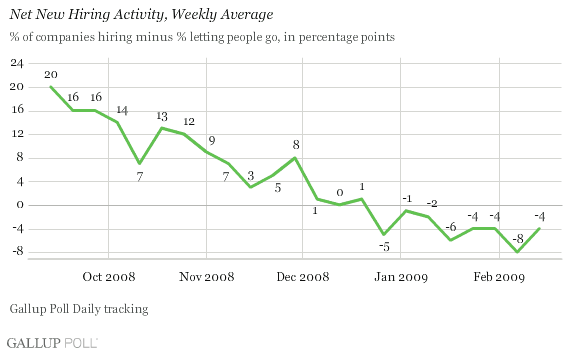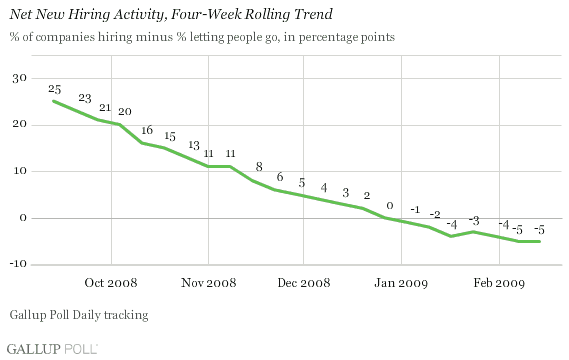PRINCETON, NJ -- shows that although U.S. employees' perceptions of the job situation at their companies remain negative -- at -4 for the week ending Feb. 14 -- they are better than the -8 of the week ending Feb. 7. This suggests that on Thursday, the Labor Department is likely to report an improvement rather than a continued deterioration in weekly jobless claims.

Gallup's Net Hiring Index Less Negative
Weekly jobless claims improved to 623,000 during the week ending Feb. 7 from a revised 631,000 the prior week. The decline in Gallup's Net Hiring Index last week indicates that jobless claims are again likely to improve a little during the week ending Feb. 14. Still, predicting small changes in weekly claims tends to be difficult given their volatility, particularly when seasonal adjustments are applied to them at this time of year.
Gallup's four-week rolling average of jobless claims is not only a more stable but also a better predictor of actual conditions in the job market. For the week ending Feb. 14, the four-week average of Gallup's Net Hiring Index was unchanged at -5. Combined with the weekly improvement in the Index, this suggests four-week average claims are likely to be essentially unchanged and above 600,000 when the government reports them on Thursday.

Stimulus Not Likely to Stem Jobs Decline
Despite last week's slowing in the downward plunge in initial jobless claims, they remain at levels not seen since the 1980s. In turn, this means the unprecedented government spending is indeed timely. It seems clear that some kind of fiscal spending bridge between the economy's current state and an economic recovery makes sense.
On the other hand, it appears that the new stimulus legislation may be better in terms of the behavioral economics art of "framing" -- that is, being positioned as something that will stimulate the economy and create jobs -- rather than in actually doing anything that will significantly benefit the jobs market this year. Probably the biggest jobs benefit associated with the new legislation is the money it sends to the states to help them mitigate the job layoffs that might have occurred in response to the budget squeeze they are currently experiencing. Otherwise, the immediate effects of this new bill are more an expansion of the federal safety net than job creation.
As millions more Americans lose their jobs in the months ahead, hopes for a real economic stimulus must now focus on the new housing plan the president will announce on Wednesday and the eventual next step in the banking bailout. Getting credit moving again is the real stimulus the economy needs right now; it is unfortunate that the so-called banking bailout has not been more effectively "framed" in this way.
Gallup.Com reports on its every Tuesday.
Survey Methods
Using weekly results for 2008, Gallup's analysis suggests that its hiring measure has a better than 7-in-10 probability of correctly projecting the direction of weekly jobless claims and a better than 8-in-10 probability of predicting the direction of the four-week average of jobless claims.
Gallup's hiring measure is based on aggregated interviews with a nationally representative sample of more than 2,000 U.S. workers each week. 优蜜传媒asks current full- and part-time employees whether their employers are hiring new people and expanding the size of their workforces, not changing the size of their workforces, or letting people go and reducing the size of their workforces. Gallup's hiring measure is computed by subtracting the "letting go and reducing" percentage from the "hiring and expanding" percentage. The assumption is that employees across the country have a good feel for what's happening in their companies, and that these insider perceptions can yield a meaningful indication of the nation's job situation.
Gallup's Net New Hiring Activity measure was initiated in January 2008. It is an effort to assess U.S. job creation or elimination based on the self-reports of more than 2,000 individual employees aggregated each week about hiring and firing activity at their workplaces. For results based on these samples, the maximum margin of sampling error is 卤3 percentage points.
Interviews are conducted with respondents on land-line telephones (for respondents with a land-line telephone) and cellular phones (for respondents who are cell-phone only).
In addition to sampling error, question wording and practical difficulties in conducting surveys can introduce error or bias into the findings of public opinion polls.
